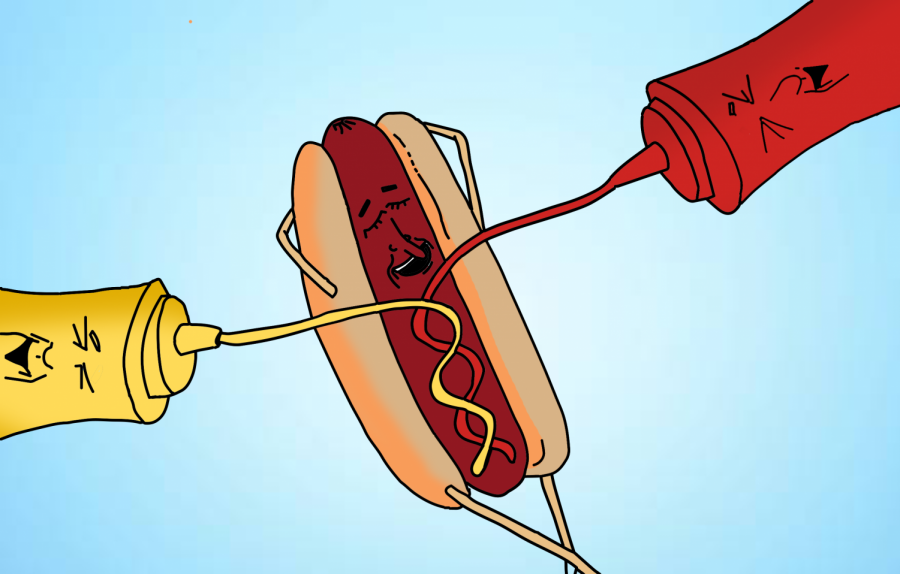Chancellor, students weigh in on age-old hot dog debate
The suspicious history of the sausage goes back centuries and is enveloped mystique and contentious debate.
Hot dogs, a food synonymous with American celebration, have been embroiled in debate for the entirety of their existence, spanning back over 150 years to Europe.
Of the many questions surrounding hot dogs is that they inhabit a peculiar space in the food categorization continuum, hanging on the precipice between the absolute and the uncertain.
The debate can be distilled down to the question of whether or not a hot dog is a sandwich.
UW Oshkosh Chancellor Andrew Leavitt falls into the camp of believing hot dogs belong to a category separate from sandwiches.
“I think it’s its own thing,” Leavitt said. “Hot dogs are a food of the gods.”
The debate can be dizzying because the lines between what constitutes a sandwich are not exactly clear. In fact, if one looks into the history or etymology of the word ‘sandwich,’ things only get murkier.
The story surrounding the invention of the sandwich goes back to 18th-century England, when John Montagu, 4th Earl of Sandwich — yes, that’s a real place — allegedly ordered a servant to bring him cold meat on bread so that he could eat at a cribbage table without soiling his cards with greasy fingers.
Whether or not this is the truth behind the birth of the sandwich is beside the point, but the sandwich, or at least the term “sandwich” became increasingly common during that period in history.
After the sandwich came into the picture, foods designed to be eaten without utensils while avoiding a mess were largely popularized. Although both sandwiches and hot dogs share this similarity, some used it in an attempt to distinguish between the two.
“I don’t consider it a sandwich,” Hot Dog Charlie’s employee Budda Farr said. “It’s more of finger food, really.”
Farr’s distinction seems to contradict itself, as both the sandwich and hot dog are finger foods by design.
Farr’s coworker Fiera Pan tried to clarify his statement.
“It’s got bread and it’s got meat, so there you go,” Pan said.
This wasn’t helping to distinguish the hot dog as something separate from the sandwich, or putting it in a category of its own.
Trying to gather insight about how to categorize the hot dog is a job not helped by its history, which is about as clear as mud. Although the original inventor and place of invention are generally debated and unknown, there are a few notions that are essentially agreed upon by hot dog historians.
“You’ve got to remember how it was invented,” Sodexo chef Fritz Niebergall said of the hot dog. “It was basically a way for someone to eat and not use silverware.”
Niebergall said the hot dog could possibly have been invented at the Chicago World’s Fair in 1893, which is also historically referred to as the Columbian Exposition, as it celebrated Christopher Columbus’ arrival to the New World in 1492.
The hot dog was likely not invented at the Columbian Exposition, but it’s widely accepted that the popularity of hot dogs at the Columbian Exposition helped cement the hot dog’s place in American gastronomical culture.
The hot dog’s story is much like the sandwich’s story. Encased meats have been around for a long time, so long that they were even mentioned in Homer’s “Odyssey.” Important clues toward the birthplace of the hot dog, however, might be found in some of the colloquial terms hot dogs are referred to.
“Franks” or “frankfurters” refer to the city of Frankfurt, Germany, where it’s alleged that the hot dog in its modern form was developed in 1487, five years before Columbus sailed to the Americas. Austria will dispute Germany’s claim to the hot dog as the term “weiner” refers to inhabitants of Vienna, or in Wein in German.
Germans are credited with the creation of the frankfurter sausage, after German butcher Johann Georghehner created what became referred to as “daschund sausages” or “little dog sausages.”
The theatrical mystique of the hot dog’s history came to its closing act in the early 20th century. Legend has it American cartoonist Tad Dorgan saw a street vendor in New York selling “dachshund sausages,” and quickly sketched a caricature saying “hot dog,” as he didn’t know how to spell “dachshund.”
Unfortunately, like other rumors in the history of the hot dog and sandwich, this tale can’t be verified. Despite Dorgan’s prolificacy, the cartoon has never been found. It may have never been made.
The argument for the hot dog-sandwich dilemma remains unclear. Most point to the bun as the main distinguishing feature of the hot dog.
“It’s a vertical bun,” UWO student Jake Baehman said. “It’s not two pieces of sliced bread.”
Leavitt also fell into the non-conforming-bun camp.
“I wouldn’t consider it a sandwich probably because the geometry is different,” Leavitt said.
Even when the geometry of the hot dog bun is taken into consideration, conflicting categories of sandwiches still perpetuate. If the feature that puts the hot dog in its own category, separate from that of the sandwich, is the sliced bun, there is still the issue of submarine sandwiches, which are traditionally not sliced all the way through, or open-faced sandwiches, which can be folded over, forming a sort of bun.
The argument may never be concluded. Many will write it off as semantic balderdash, while other will remain loyalists to either the sandwich or separate side of the debate. If the bun is the distinguishing feature, the hot dog-sandwich relationship could be comparable to the square rectangle relationship: all hot dogs are sandwiches, but not all sandwiches are hot dogs.
At the end of the ballgame, it comes down to each individual’s perspective on the matter. Is a hot dog a sandwich? Well, it depends who you ask.










